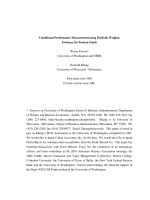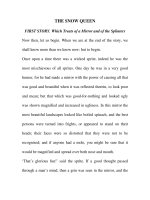Second Conditional
Bạn đang xem bản rút gọn của tài liệu. Xem và tải ngay bản đầy đủ của tài liệu tại đây (69.74 KB, 2 trang )
Second Conditional
Use:
The second conditional structure is used to talk about imaginary situations and the
consequences.
Example: If I had a car, I could visit my friend.
(But the truth is, I do not have a car, and I cannot visit my friend).
The second conditional structure is also used to talk about imaginary abilities and the
consequences.
Example: If I could fly, I wouldn’t need a car.
(But the truth is, I cannot fly, and so I need a car.)
Form:
1) Make the second conditional in this way.
If I
you
he
she
past simple , I
you
he
she
would / wouldn’t
‘d
could / couldn’t
verb
(infinitive form)
Example: If we had more money, we would buy that house.
Or
I
you
he
she
would / wouldn’t
‘d
could / couldn’t
verb
(infinitive form)
if I
you
he
she
past simple
Example: She’d be more successful if she worked harder.
2) The verb to be can use were for all subjects. This is particularly true in the sentence: If I were
you…
If I were you, I’d buy a bicycle.
However, this rule is often overlooked.
If he were more careful, he wouldn’t break everything. =>
If he was more careful, he wouldn’t break everything.
3) To talk about imaginary abilities, use could.
If I could + verb (infinitive) , I would / wouldn’t verb
you
he
she
you
he
she
‘d (infinitive form)
Example: If I could help you, I would!
4) Notice that the infinitive verb after the modal verbs is not necessary if the meaning is clear.
Don’t contract modal verbs when there is no infinitive verb present.
If I could pay, I’d. => If I could pay, I would.
Common errors:
1) Many students write would after If
If I would have a lot of money, I would buy that car!
=> If I had a lot of money, I would buy that car!
2) Many students forget to use could to talk about abilities.
If I played the drums, I’d join a band.
=> If I could play the drums, I’d join a band.









